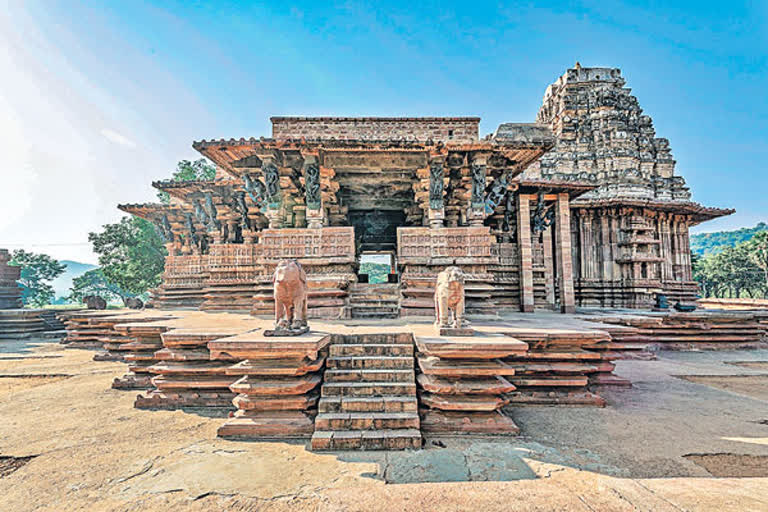Hyderabad (Telangana): Ramappa Temple in Mulugu district is one of the fascinating destinations in Telangana. The temple made it to the United Nations Educational, Scientific and Cultural Organization’s (UNESCO) World Heritage list for the year 2019. The decision was taken at the 44th World Heritage Committee session of UNESCO held on Sunday in China. Three historical sites, including Qila Warangal and the thousand-pillared temple all from the erstwhile Warangal district were in the race from Telangana. However, the iconic Kakatiya construction with its unique style, architectural prowess and technology was finalized as the World Heritage Site.
India’s strategic move
The UNESCO recognition did not come so easy. India had to make several diplomatic moves. Russia supported us in the process. The temple was nominated for the list in 2019. A World Heritage recognition is possible only by the approval of the World Heritage Committee (WHC). The same year, the International Council on Monuments and Sites (ICOMOS) visited Ramappa, and pointed out 9 areas of improvement. Soon afterwards, India explained the greatness of the majestic monument to the countries participating in the WHC voting, and emphasized the need for UNESCO recognition.
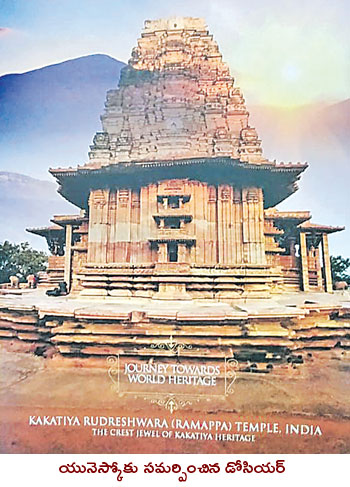
Read: Telangana's Ramappa temple bags UNESCO heritage tag
Postponement and diplomatic efforts
At the WHC conference held in Fuzhou (China), ICOMOS posed yet another roadblock, and decided that the nomination process of Ramappa temple be further deferred. Russia immediately invoked Rule 22.7, wherein Ethiopia, Oman, Brazil, Egypt, Spain, Thailand, Hungary, Saudi Arabia and South Africa extended their support. Norway, however, had some reservations. ICOMOS mentioned the shortcomings it pointed out during its visit to Ramappa and demanded huge changes be made in the premises of the site.
Other countries suggested only minor changes. A huge debated ensued following the recommendations. But Ramappa was finally inscribed as a World Heritage Site with the support of Russia and 17 other countries. In fact, the UNESCO recognition for the temple was supposed to be considered last year itself but the WHC conference got postponed due to the pandemic.
In order to achieve World Heritage Site status, the site must geographically and historically be unique. This is referred to as outstanding universal value. These features were comprehensively embodied in the dossier submitted for the process of nomination. The Archaeological Survey of India spent about Rs 25 lakh to prepare the dossier. During the process of nomination, it was reverted thrice following the questions posed by UNESCO representatives. The dossier was prepared through a consultancy called Kshetra.
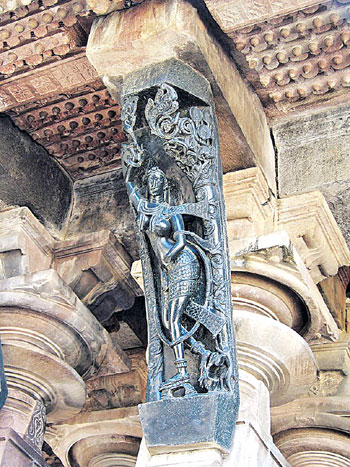
39th in the country
Ramappa was the first to have achieved this status among the Telugu states. UNESCO gives the status to unique heritage sites, natural wonders or a combination of both. Till date, 38 sites have been accorded this status in the country so far. Of these, 30 are heritage buildings, 7 are natural wonders and the remaining one is a place where history meets nature. At 6, Maharashtra has the highest number of UNESCO Heritage Sites in India.
Others that made it to the list
Apart from the Ramappa temple, the World Heritage Committee inscribed 'Quanzhou: Emporium of the World in Song-Yuan China (China)', the 'Trans-Iranian Railway (Iran)', 'Paseo del Prado' and 'Buen Retiro', a landscape of Arts and Sciences (Spain), on UNESCO’s World Heritage.
Read: Peddi Reddy resigns from BJP, second senior leader to quit after Eetela Rajender's entry
Why Ramappa Temple?
- Floating bricks - Though the exterior of the temple was built using red sandstone, the roof was built with bricks so light that they float on waterFloating bricks

- Sandbox technique - Despite invasions, wars, and earthquakes, the temple remained intact as its foundation was built using sandbox technique
- Black basalt - The intricate structures inside the temple were carved of black basalt
What does it mean for the site?
With UNESCO recognition, Palampeta village where the site is located, is sure to get international visibility. The site is to get funding from the World Heritage Fund and World Heritage Publications. Not just this, several non-government organizations across the world will donate funds for its development. The Archaeological Survey of India will have to allocate special funds for the site's maintenance. With the influx of tourists, local employment opportunities will improve. The state government has to improve travel and other amenities to the site. The ongoing works at Mamnoor airport are likely to pick pace. The stone pavement unearthed during the construction of road before Ramappa Temple will be scientifically excavated and put on display.
"Recognition for a prosperous heritage, Kakatiya Rudreswara Temple as a UNESCO World Heritage Site is a proud moment. Congratulations to the people of Telangana," Venkaiah Naidu, Vice President of India tweeted.

"The iconic Ramappa Temple showcases the outstanding craftsmanship of great Kakatiya dynasty. I would urge you all to visit the majestic Temple complex and get a first-hand experience of its grandness," said Narendra Modi, Prime Minister of India
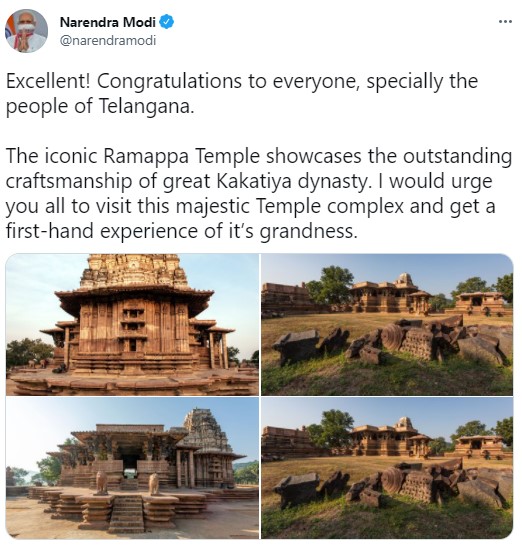
"Ramappa Temple being declared as World Heritage Site is a happy moment for the country. This iconic temple is a fine example of great Indian craftsmanship and sculpture," Union Home Minister Amit Shah said.
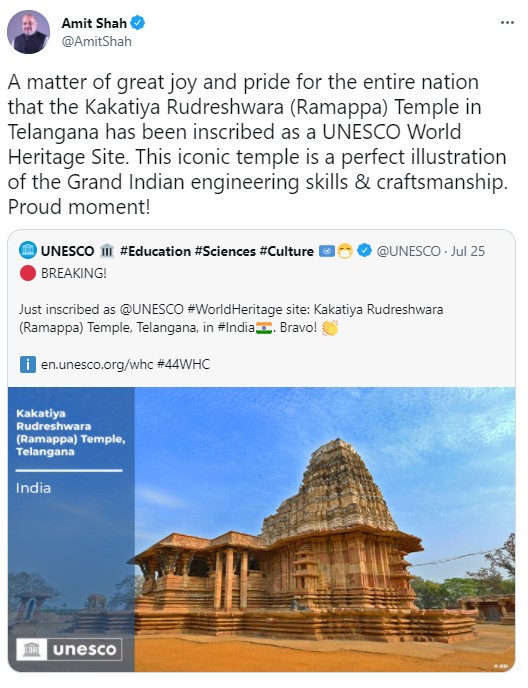
Read: Magnitude 4 earthquake strikes near Hyderabad
Chief Minister of Telangana, KCR, said that Telangana is proud that UNESCO declared Ramappa a World Heritage Site. He added that the rulers of Kakatiya dynasty have constructed several iconic monuments which boast of exemplary architectural finesse. He further stated that the state government was striving hard to bring recognition to the sites of historical importance in Telangana. He expressed his gratitude to the members in the WHC conference who had helped bring this laurel to the Temple. He said that this was the first such recognition to the state from UNESCO. Minister KT Rama Rao, too rejoiced at the news. He said that they are aiming to bring Heritage Site recognition for Hyderabad as well.
Union Minister Kishan Reddy speaking to ETV Bharat thanked the Prime Minister on behalf of the people of Telangana. He said that he was with Home Minister Amit Shah in Kamakhya Temple when the news was announced. He added that along with the Prime Minister's Office, the Department of Tourism has also worked hard for a while. Initially, the UNESCO committee had reservations about inscribing World Heritage Status to Ramappa. Kishan Reddy also thanked the ASI team for the laurel.
Recognition of Ramappa Temple as a World Heritage Site
Though Hyderabad is noted for places like Golconda Fort, Charminar, Qutub Shahi Tombs, the thousand-pillar temple and Warangal Fort in Warangal as well as other historical places of India, it is the Ramappa Temple located in the fort city of Warangal, that has successfully attained the status of the UNESCO World Heritage Site. Achieving this recognition was not an easy. There have been innumerable attempts and strategies of both – the State Government and the Central Government, to bring the specialty of this temple to the notice of the entire world.
Advantages of a Cohesive Geography
The Ramappa Temple was recognized as a World Heritage Site because of the special architecture and qualitative construction of the temple structure with its special materials that have stood the test of time, since many decades. In addition, cohesive geographical advantages such as absence of other constructions and encroachments in and around the main structure have also played an important role in achieving the same. Earlier, attempts have been made for UNESCO recognition of Golconda Fort, Charminar and Qutub Shahi Tombs. Accordingly, proposals have gone to the Archaeological Survey of India (ASI) from the state.
In order to be given World Heritage status as per UNESCO rules, there should be no other structures within 100 meters of the said building. A radius of 200 meters should be considered as protected zone around the structure. The structure must be unique, unlike any other building in the world. Proposals for these structures stalled early on due to non-compliance with these regulations and other issues. The Thousand Pillars Temple and the Warangal Fort were initially set aside for non-compliance with UNESCO regulations. However, the Ramappa Temple was selected for the same.
Read: TRS MP sentenced to 6 months imprisonment
The government has focused on the three structures - Ramappa Temple, Thousand Pillars Temple and the Warangal Fort to be recognized under the World Heritage Sites. Accordingly, in the year 2010, the then government set up a committee to send proposals to UNESCO requesting for the status of heritage sites.
Later, in the year 2016, a proposal was sent to UNESCO seeking recognition for the Ramappa Temple. The proposal was rejected stating that the required details of the temple specialties not properly listed out. Post the same, UNESCO Consultant and dancer Ms. Choodamani Nandagopal visited and studied the specifics of the temple and sent the details to UNESCO. Following which changes were made to the dossier to this extent. In 2019, a team from UNESCO team under the leadership of Sri. Vasu Poshananda came and inspected the temple. The team suggested various steps to be taken for the protection of the temple and its surroundings. Accordingly, the state government made the required changes.
Retired NIT Professor Pandurangarao, retired IAS official Paparao and Architect Surya Narayana Murthy worked with the Kakatiya Heritage Trust for efforts on attaining the recognition of Ramappa.
Suggestions made by ICOMOS
In addition to the efforts of the Central and State Governments, the advice and suggestions of the International Historical Monuments and the Land Council (ICOMOS) have also helped the Ramappa Temple in becoming a UNESCO World Heritage Site. In September 2019, a council delegation visited the Ramappa Temple. The Telangana government has taken several steps, including changes in the boundaries of the temple, in response to suggestions made by the council on the occasion. This activity was implemented at a rapid speed.
A committee has been set up under the chairmanship of the Secretary, State Department of Culture and Tourism to implement the Archaeological Conservation Plan (CMP) and tourism development in the vicinity of Ramappa. The Central Archaeological Department, Revenue Department, City Planning and Irrigation Department officials have been appointed as members of this Committee.
Read: Hanumantha Rao returns home after undergoing kidney treatment
The Palampeta Special Development Authority (PSDA) has been set up by the State Municipality to protect the pond, hills, forest lands, natural beauty and sanctity around the Ramappa Temple. Minister for Municipal Department, KT Rama Rao took the decision on the same day and issued the orders.
ICOMOS suggested that the two smaller temples not far from the temple should also be included in the Ramappa temple vicinity. Accordingly, the Mulugu District Collector issued an official notification handing over the land with two small temples to the temple authority itself.
Information on the orders was sent by the Telangana government to the Permanent Representative of India to UNESCO four days ago. Ramappa sent a specially printed book and brochure to the Permanent Ambassador to let the selection committee know of the speciality and popularity of the Ramappa Temple.

